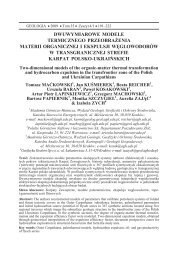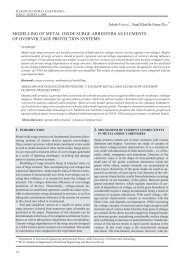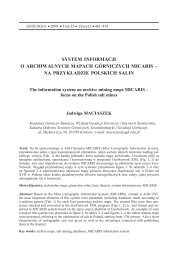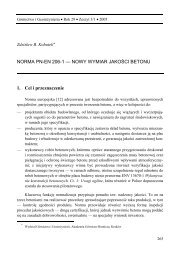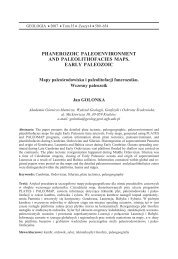You also want an ePaper? Increase the reach of your titles
YUMPU automatically turns print PDFs into web optimized ePapers that Google loves.
146 J. Wachowiak, M. Pawlikowski & P. Wilkosz<br />
– The sequence of layers observed in the pro les (Figs 3, 4) was astratigraphic. Many units<br />
were reduced or completely wedged. Such rigid rocks as anhydrites, shale or zuber were<br />
torn into blocks, boulders or debris and dragged out within the diapir up to its surface by<br />
elevating rock salt anticlines. We found them often in that form in the drilled cores.<br />
– In the ceiling and bottom sections of the drilled-through rocks, the older rock salts (Na-2)<br />
were fund, while thin and reduced younger series (Na-3), separated tectonically with<br />
older salts (anticlines?), were revealed in the middle section.<br />
– The evaporites of cyclothem PZ-2 were represented by white and white-greyish salts,<br />
with many transitional hues, and scarce thin potash salt inserts, represented by kieseritic<br />
sylvinite. The presence of small kainite and polyhalite admixtures in those salts indicated<br />
typical hard salt compositions. The mineral composition calculated with chemical<br />
data indicated that we dealt with hard sylvine-kieserite salt, with kainite admixtures.<br />
– The cyclothem PZ-3 rocks were composed of orange-pink, both pure and clayed, and<br />
smoky rock salts (found in the Kujawy region diapirs for the rst time), as well as zubers,<br />
clay salts and anhydrites, with laminas and thin layers of potash-magnesium salts<br />
(hard salt as above and potash salts without kieserite).<br />
– A number of mineralogical and petrographic features, presented in this study, indicated<br />
the epigenetic character of potash-magnesium salts found in boreholes Z-9 and Z-17.<br />
– In the borehole Z-9 and Z-17 cores, we did not identify any presence of such correctly deposited<br />
lead horizons as anhydrites (A-1, A-2 and A-3), dolomites (Ca-2), grey salt clay<br />
(T-3), and stinking schist (T-2), or clear mineral horizons that had been well documented<br />
in other salt diapirs, e.g. those of Kodawa, and used as lithostratigraphic tools (Werner<br />
et al. 1960, Burliga et al. 2008, Wachowiak 2010, Czechowski et al. 2011). Clear lithostratigraphic<br />
separation of the studied layers was dif cult to acquire in the conditions of<br />
tectonic development of the layers where rock salts of various ages were in direct contact<br />
with each other, without the presence of the above-mentioned lead horizons.<br />
– In the studied evaporite and siliciclastic rocks, the occurrence of 18 minerals was identi<br />
ed, e.g. halite, sylvine, kieserite, epsomite, polyhalite, kainite, anhydrite, gypsum,<br />
boracite, magnesite, dolomite, calcite, quartz, talk, chlorite, illite, pyrite, hematite.<br />
We should mention that epsomite, occurring abundantly on the surface of potash-magnesium<br />
salts, is the present-day product of kieserite weathering (hydration). Gypsum,<br />
found in zubers in the form of idiomorphous crystals, is also most probably a present-<br />
-day epigenetic mineral.<br />
– Detailed characteristics of those minerals, as well as of other processes and mineralogical<br />
and geo-chemical transformations occurring in the drilled-through deposit, will be<br />
the object of a separate study.<br />
FINAL REMARKS<br />
Owing to intense continuation of the expansion of the underground natural-gas storage<br />
facility in the Mogilno II deposit (construction of 10 more caverns), it is absolutely necessary<br />
to recognize in detail the internal geological structure of the Mogilno diapir to determine the<br />
best possible locations for those caverns.



